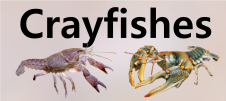






Loading profile. Please wait . . .
Procambarus caritus Hobbs, 1981
Poor Crayfish




Federal Protection: No US federal protection
State Protection: No Georgia state protection
Global Rank: G4
State Rank: S3
Element Locations Tracked in Biotics: No
SWAP 2015 Species of Greatest Conservation Need (SGCN): No
SWAP 2025 Species of Greatest Conservation Need (SGCN): No
2025 SGCN Priority Tier: None
Element Occurrences (EOs) in Georgia: 0
Habitat Summary for element in Georgia: Complex burrow systems in low wet areas where the water table is near the surface of the ground
The overall color of the Poor Crayfish is brown with no distinguishing markings; however, it may have a pinkish or olive hue on the carapace and/or abdomen. The lower sides of the body are lighter than the back and the claws have a purplish or bluish tint. The claws are covered with dark tubercles. The mesial margin of the palm has a single row of jagged tubercles and the areola is very narrow. The rostrum tapers, is concave, and almost spatulate; there are no marginal spines or tubercles. This species reaches a maximum total body length of about 65 mm (2.6 in).
Within its range, there are two species that could possibly be confused with the Poor Crayfish: Christmas Tree Crayfish, Procambarus pygmaeus, and Mole Crayfish, Procambarus talpoides. The Christmas Tree Crayfish typically has obvious green and red coloration but details of the male first pleopod are required to separate the Poor Crayfish from the Mole Crayfish.
The Poor Crayfish is considered a primary burrower and inhabits complex burrow systems in low wet areas where the water table is near the surface of the ground.
No studies of the Poor Crayfish are known and the diet of burrowing crayfishes in general is poorly understood. Crayfishes are considered opportunistic omnivores and likely feed on a variety of items, both plant and animal, living or dead. Burrowing crayfishes may forage around the mouths of their burrows, eat organisms that crawl or fall into the burrow, or eat worms that inadvertently tunnel through a burrow wall.
Burrowing crayfishes inhabit a system of tunnels that may be very complex with several openings to the surface. Openings to the tunnels are often marked by piles of dirt or mud pellets (chimneys). Depending on the soil type and moisture content, these chimneys can reach heights of 15 cm (6 inches) or more. These crayfishes are typically confined to their burrows, but a male must leave its burrow to search for females during the reproductive season. As mentioned above, they may also forage near the opening of their burrow. Active burrows with fresh soil are seen from late spring to late fall, particularly after rain events. During the dry part of the summer, burrow openings may be plugged to help conserve moisture in the burrow. Reproduction probably occurs during the spring and fall, but males in reproductive condition may be found at any time during the year. It is very rare to find more than one adult crayfish in the same burrow. When a female crayfish releases her eggs, she attaches them to her swimmerets and is said to be “in berry.” Upon hatching, the juvenile crayfish are attached to the mother by a thread. After the juveniles molt for the second time, they are free of the mother, but stay close and will hold on to her for some time. Multiple juveniles are occasionally found in a single burrow. Eventually they move off on their own. Crayfishes molt 6 or 7 times during their first year of life and most are probably able to reproduce by the end of that year. They molt once or twice a year for the remainder of their lives. Although it is difficult to study burrowing crayfishes, some researchers believe they may live as long as 10 years. Male Poor Crayfish in reproductive condition have been collected in April, although Hobbs (1981) reported that three non-reproductive males molted into reproductive condition in the laboratory in September and October. A female carrying eggs and young was found in April, one with eggs was found in September, and one with larger young (~0.8 in) in the burrow was also found in September (Hobbs 1981). The smallest breeding male found is about 50 mm (2.0 in) and the smallest female with eggs is about 60 mm (2.4 in) in length (Hobbs 1981).
Burrowing crayfishes may be collected by direct excavation of their burrows, by trapping, and during night surveys. Excavating burrows is time consuming and can be very difficult. It also results in destruction of the animals’ burrow. Traps made with PVC pipes or mist nets can be effective. Burrowing crayfishes are sometimes captured around the openings of their burrows on damp nights. Active burrows are typically found from about mid-March to mid-November if the water table is within about two feet of the surface of the ground.
Poor Crayfish are known only from Georgia in the Altamaha, Ocmulgee, Oconee, and Satilla river systems.
Activities that destroy burrows or alter hydrology in the vicinity of burrows threaten this and other burrowing species.
This species is common and widespread and therefore is considered stable.
If possible, areas with burrows should be protected from land disturbing activities. Additional surveys and life history studies are needed to better understand virtually all burrowing crayfishes to allow predictions of their response to environmental change. Environmental education programs should include information about burrowing crayfishes.
Hobbs, H.H., Jr. 1981. The crayfishes of Georgia. Smithsonian Contributions to Zoology 318:1–549.
Taylor, C.A., G.A. Schuster, J.E. Cooper, R.J. DiStefano, A.G. Eversole, P. Hamr, H.H. Hobbs III, H.W. Robison, C.E. Skelton, and R.F. Thoma. 2007. A reassessment of the conservation status of crayfishes of the United States and Canada after 10+ years of increased awareness. Fisheries 32:372–389.
Christopher E. Skelton
C. Skelton, August 2012: original account
C. Skelton, March 2019: general update of account.